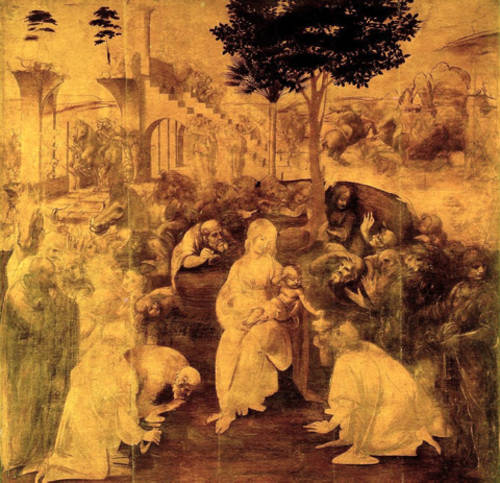One of the Uffizi’s masterpieces, the unfinished Adoration of the Magi by Leonardo da Vinci, has been absent from the gallery since 2011 undergoing a meticulous but complicated restoration in Florence’s famous state restoration laboratory. It has just been returned and is currently on view in a special exhibition on the first floor (it will remain there until 24th Sept, when it will once again take its place in the gallery, but in a new room specially designed for it). Centuries of surface dirt have been removed as well as the varnishes added over the years, and a microscopic restoration of the paint has been completed. The result is outstanding: the work is now thought to be as Leonardo left it, an unfinished painting, with some areas more complete and others just sketched, some with paint, others with charcoal.

The room which leads into the exhibition has been newly arranged with just two works superbly lit: the famous Annunciation by Leonardo, and his master Verrocchio’s Baptism of Christ, on which it is known that Leonardo worked (it is traditionally thought he painted the angel in profile, and it is now suggested he intervened also on the figure of Christ himself, and part of the landscape). We know that the Annunciation was painted while Leonardo was still in Verrocchio’s workshop but strangely we know nothing about who commissioned it or where it was to be placed. It is a truly wonderful painting, with every detail highly finished, from the landscape to the flowery meadow, from the classical sarcophagus to the transparent white veil of the Madonna. So it is all the more fascinating to be confronted in the next room with the Adoration of the Magi where one feels one can experience Leonardo’s moods and whims as he experiments with placing a horse here or there; inserting a strange classical building under construction (with its architect observing the work); deciding whether to include a camel, an elephant, a group of dogs; inserting some dark trees in certain places, as the entire scene begins to take shape.
The Madonna herself seems isolated in the middle of all this action, in her beautiful calm serenity, even though her cloak seems to have been caught up in a bizarre fold beneath her thigh. And the Child (with some of his curls still to be completed by the artist) has been given a superior air as he blesses the genuflecting king before him, but amusingly decides to ‘receive’ his gift by playfully just taking off its lid and leaving the heavy vessel in the old man’s hands. (One wonders if that is why Joseph in the background is seen holding just the lid of one of the other king’s gifts and why Leonardo decided to alter this detail from the drawing in which the Child takes the entire vessel from the king, resulting in the Virgin having to hold on tight to him because of its weight). The Three Kings are interpreted by Leonardo as rather terrifying old men, and the thoughtful figure conspicuous on the extreme left, painted in shades of dark brown, remains a mysterious onlooker (just one of the many enigmatic figures present). The numerous horses, one shown perfectly head-on to us and others only just taking form, are amongst the most fascinating details. Leonardo left the work at this stage since he was called away to Milan in 1482.
The exhibition also includes photographic reproductions of two of Leonardo’s drawings (one from the Louvre and one from the Uffizi’s prints and drawings collection) related to the Adoration, blown up so that one can see the various details. The former is interesting above all to show not how it relates to the ‘finished’ work but how it differs from it, and also shows just where Leonardo thought at first to place the kings, which he left sketched in the nude. Seeing these one does feel this would have been the occasion to have shown the originals of some of the other preparatory drawings by Leonardo (if only from the Uffizi’s own collection).
The exhibition also includes Filippino Lippi’s Adoration of the Magi because it was the work that the Augstinians commissioned in 1496 for their church, San Donato a Scopeto, outside the city walls (destroyed a few years later in the 1529 siege of Florence) when it became clear to them that Leonardo would never return from Milan to complete the Adoration they had originally commissioned. Filippino’s Adoration (which is exhibited beside three very mediocre panels of its predella, two now in the North Carolina Art Museum and one from a private collection) comes as a shock after Leonardo’s work as it is in such a completely different world, with an atmosphere totally diverse. The decision to include it here, to illustrate the history of the commission, was correct but this work, although Filippino was one of the great artists of his time, simply cannot be appreciated next to the Leonardo.
We now know that Leonardo’s work was never consigned to the monks of San Donato. According to Vasari it remained in the house of Amerigo Benci so was probably seen there by other artists of the time. By 1670 it had entered the Medici collection.
In the last room there is a reproduction of Leonardo’s work to scale which, using reflectography, revealed that there was a “faint, freehand drawing beneath the brushwork”. The other details of the restoration are well documented in a film. At one stage the carabinieri were called in to prove that certain marks found on the surface were indeed the fingerprints of the master, as well as, in one area, the impression of the palm of his hand.
by Alta Macadam, author of Blue Guide Florence, where this masterpiece is described on p. 134 of the new edition, just out.






